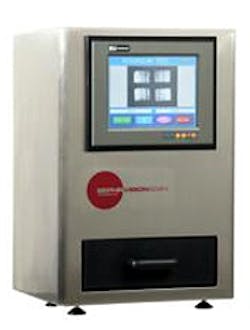Vision systems spots defects in blister packs
A new whitepaper published by Dr. Dorian Dixon, a packaging expert at the University of Ulster (Newtownabbey, Co. Antrim, Northern Ireland) claims that a system that inspects pharmaceutical blister packs can identify 100 per cent of defective pockets across a range of different pack types.
In contrast to traditional destructive, manual tests such as blue-dye, the VisionScan system developed by Sepha (Dundonald, Northern Ireland) uses a vision system to detect defects.
Four blister pack types of various designs and materials were evaluated by Dr. Dixon. Laser drilled holes of 15μm or 50μm were drilled into the foil or paper laminate of 25 of each of the four pack types, creating a total of 200 initial test packs. Only one pocket per pack was laser drilled, leaving the remaining pockets undamaged as control pockets.
Scanning Electron Microscopy (SEM) was used to confirm the dimensions of the laser drilled holes. On SEM inspection of the initial 200 test packs it was shown in a number of blister packs that the laser drilled holes were not drilled correctly or were missing. Data from the pockets identified as having defective holes was not included in subsequent analysis, resulting in a total of 170 test packs for final analysis.
Once all such incorrectly drilled pockets were removed, Dr. Dixon found that the VisionScan system correctly identified 100 per cent of both the 15μm and 50μm sized defects in the 170 test packs across all four of the blister pack types.
"As VisionScan is a non-destructive test using vision technology, it removes the possibility of human error and subjectivity, whilst allowing valuable product within defective packs to be recovered. This represents a significant improvement over traditional blue-dye testing, which is both subjective and destructive," Dr. Dixon says.
Dr. Dixon's whitepaper is available here.
Related articles from Vision Systems Design that you might also find of interest.
1. Medical parts get a clinical checkup
A vision-based inspection has been developed to examine multicavity injection-molded sub-assemblies used in the medical industry.
2. Vision system inspects medical fibers at high speed
Adsys Controls (Irvine, CA, USA) has developed an automated system capable of inspecting abnormalities on medical fibers as small as 1 µm at rates up to 30 m/s.
-- Dave Wilson, Senior Editor, Vision Systems Design
